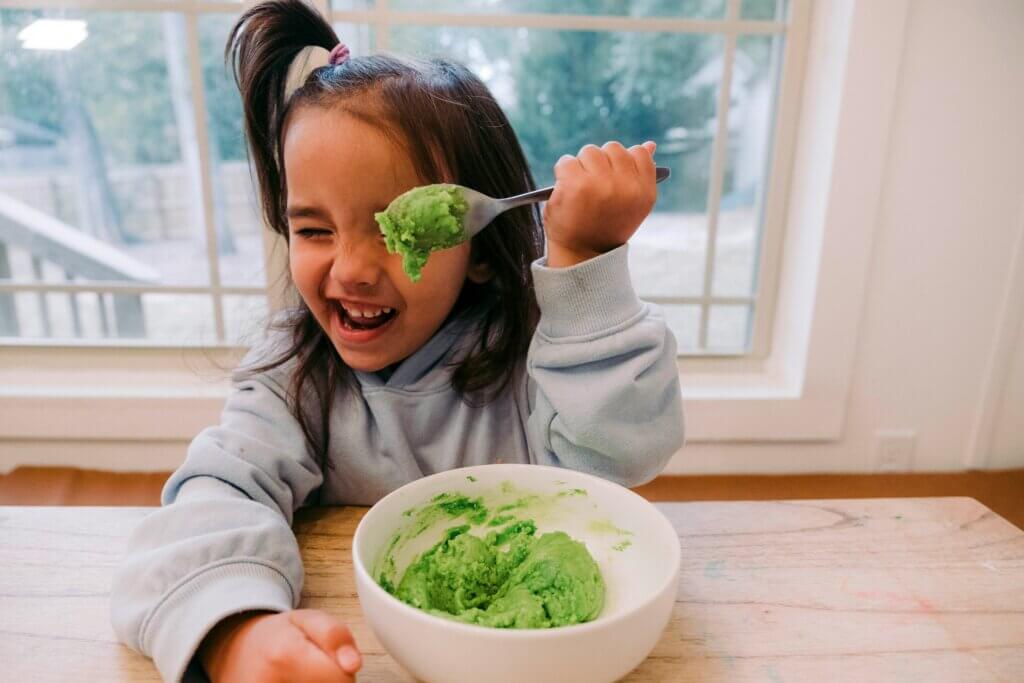Teaching Body Positivity to Nanny Kids
I remember feeling absolutely gutted when the sweet kindergartener I used to nanny for made a passing comment about her “big tummy” as we were reading books together one afternoon. I was heartbroken, shocked, and absolutely froze. I wanted to say, “No! You don’t have a big tummy! And even if you did, big tummies are amazing! You’re perfect and beautiful and strong!” But I had no idea if that was “the right” thing to say at that moment. Honestly, I can’t even remember what I said, but her comment has certainly stuck with me. The next time this happens, I do know what I’m going to say, and it’s going to be all about body positivity.
How do I know this is going to come up again? Unfortunately, research is showing that preschool and elementary-aged children are dissatisfied with their bodies more now than ever before (up to 70%!), and that girls as young as 3 perceive heaviness as bad and thinness as good. Another study showed that ⅓ of 5-year old girls restrict their food. WTF! How can we possibly combat the clearly very effective messaging that young children are getting about what their bodies are supposed to look like?

Small, frequent conversations
Just like talking to kiddos about race, sex, or other topics that can make us feel uncomfortable, it’s a better idea to have many small conversations rather than count on one huge talk to cover everything. This can be extra tricky as a nanny because we have different boundaries and need to be conscientious about being appropriate & mirroring the values of the families we work for. Talking about this with the parents you work for ahead of time to get on the same page is a great idea, and in my experience, it will be well received that you’re thinking ahead!
The start of these conversations is often spurred by the child bringing it up. Listen to what a child says about their body. Even if it sounds alarm bells like the “big tummy” comment, stay neutral & try not to freak out. If they use the word “fat,” avoid admonishing them. “Fat” can have a lot of baggage and meaning to us, but for a child, it might just mean “big.” I have a very fat cat and often use the word fat when describing him. It doesn’t mean he’s bad; he’s just a big guy. When you hear a child commenting on their body or other bodies, you can reply with a simple,
“All bodies are different, that’s what makes us each unique,” just like if they were commenting on someone’s height or eye color.
A Mighty Girl recommends using the phrase, “All bodies are good bodies,” which I adore. If a child brings up body sizes in public, like pointing out a large body at the grocery store, that’s just a cue that the child is curious, noticing differences, & wants to talk more about this. You don’t need to do it at that moment at the grocery store – this might be a time to use the “all bodies are good bodies” phrase, but once in the car or at home, lean into it and have that conversation so the stigma isn’t perpetuated. Kids are just curious & observant; they’re not being malicious when they do this!
If it is swept under the rug, it adds to the “taboo” nature of the topic. This is where shame grows.
Be thoughtful with your language
So what does it sound like when we’re having these conversations? How do I make sure I’m not making things worse? Be thoughtful and intentional with language. A Mighty Girl suggests instead of making comments about what people’s bodies look like, show what their bodies can do. If your nanny charge pointed out a large body at the library, you could point out how cozy & cuddly their lap is for their child. If a child points out someone who’s extremely tall, you can mention how nice it must be to reach the top shelf at the store.
One last tip from A Mighty Girl is to only give compliments to people for things that they can choose. These can be things like a fun dyed hair color, cute shoes, or how they showed care for a friend. We don’t need to tell little girls how beautiful they are and tease them about boyfriends or tell little boys they’re going to be heartbreakers when they grow up. It’s a little creepy, isn’t it? Instead of focusing on looks, use encouragement to cheer on personal choices and the effort you see them making.
We can help break the narrative of “thin bodies are good bodies” by eliminating a lot of that from the conversations we have with and in front of children.
Never talk about dieting or losing weight in front of children. Don’t talk badly about your body, and try to avoid labeling foods as “good” or “bad.” None of that is helpful or positive messaging. Little kiddos don’t want or need to hear their parents or caregivers talking badly about their bodies. Watch what they’re picking up from media as well. My kindergarten buddy who mentioned their “big tummy” loved to watch a particular children’s show about gymnastics, but I didn’t like hearing the young girls on the show talking about counting carbs or being too flat chested, so I simply stopped putting that show on.
Use books
If you’re still not sure what to say or how to get started, use books to help! Two of my favorite body positivity books are “Bodies are Cool” by Tyler Feder and “It’s Okay to be Different” by Todd Parr. There are lots of options out there! This is also a good time to do a spot check and make sure that your nanny charges are getting books with lots of diverse characters. Flip through some of the books on their shelf – are you seeing different sizes of bodies? Different skin tones? Are their options with female, male, and nonbinary protagonists to choose from? You can always pop into the library if your nanny kiddo’s library needs a bit more diversity!
Model Body Positivity
One last way to nourish a healthy, loving body image in our nanny kiddos is by modeling our own body positivity & self-love. This can be truly difficult if you have your own storied history with weight & body image, but it’s well worth the self-reflection & work to make small steps forward. We can model healthy eating. I love the work of Ellyn Satter and the Division of Responsibility in Feeding. This eliminates arguing about food, how many bites need to be eaten of what, “earning” desserts, & many other food dramas. We don’t need to praise kids for what they eat or how much they are (or are not) eating. Staying as neutral as possible about food helps everyone involved because it encourages children to listen to their own hunger cues and in turn gives them more autonomy over their body. In fact, Plant-Based Juniors, who offer evidence-based nutrition & feeding info, recommend against restricting any food (even candy!) and instead focusing on “offering intentional structure around meals [and] snacks.” Including kids in cooking is also a way to nourish a healthy relationship with food. Practice self-care & self-love in ways that feel good to you. Verbally point out things you love about your body (both to yourself and in front of your nanny kiddos), and consider exploring some positive affirmations.
I, personally, spend way too much of my time and effort thinking about body image, dieting, & beauty ideals. It’s exhausting, boring, and frankly, a waste of my time. I would love to do anything and everything I can to help prevent any of my sweet nanny kiddos from getting stuck in this same trap of unattainable beauty ideals, so I’m going to keep reading those books, checking my language, and modeling body-acceptance and love. Every effort we make in this arena sets our nanny child(ren) up for success, and I’m ready for the next time a kiddo brings up their “big tummy.”





Comments